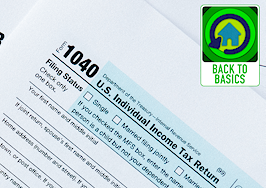You just sold a property. The commission check is about to hit your bank account. Time to party, right? Not so fast. It’s not time for bottle service just yet.
Every dollar in that commission check has a job to do, and it’s not all earmarked for bubbly. Savvy agents know this. They’ve probably already felt the pain of not having cash in the right place at the right time.
That’s why many of the top-tier agents we work with use a simple cash-management strategy to keep all their dollars in line and working hard. You might know this strategy as the “envelope method” or the “bucket method,” or as a simplified version of Mike Michalowicz’s Profit First method. Whatever you call it, it works.
Business accounts
First, let’s start with your business accounts. You’ll need five of them. The type doesn’t matter; just be mindful of fees and account minimums.
Your first business account is your revenue account. Every commission check gets deposited here, but no money stays in this account for very long. It’s just a clearing account. You will be taking all the funds out of this account and allocating them to the other four business accounts.
Your second business account is your tax savings account. Move 25 percent to 30 percent of each commission check from your revenue account to this account. This account is pretty self-explanatory. You will use the funds here to pay your estimated quarterly taxes.
Your third business account is your operating account. Move 40 percent of each commission check from your revenue account to this account to pay for your business operating expenses. Things like salaries, lead generation, software, MLS dues and other expenses should be paid from this account.
If you use a credit card for your business expenses, pay the balance on the card from this account each month. This account is also where you’ll pull your monthly salary, regardless of whether you take owner draws or pay yourself a W-2 salary.
Your fourth business account is your reserve account. Move 10 percent of each commission check from your revenue account to this account to get you through the slow-selling months.
We typically recommend keeping about three months’ worth of operating reserve in this account so that you won’t have to scramble to pay for business expenses when commission checks are few and far between in January, February and March. This account is typically depleted in Q1 of each year and replenished between Q2 and Q4.
Your fifth business account is your profit account. Move the remaining 20 percent to 25 percent of each commission check from your revenue account to this account. Buy champagne with it, if that’s your thing. But a wiser use for it would be to get those profits into investments that will grow over time — some of which will be outlined in the next section on personal accounts.
If you’re starting, go with these percentages. As your business grows, you will need to re-examine them. Your tax bracket will change, your expenses will boost, and your profit margin will usually decrease (even as your total earnings rise), so it is wise to re-examine these allocation percentages at least once a year.
Personal accounts
You know you will fund your personal accounts via W-2, or the owner draws from your operating and profit business accounts. But now what?
Time to optimize your personal finances, so all that hard work you’ve done in your business doesn’t go to waste. The first personal account you need is your checking account, which is all about convenience.
Checking accounts aren’t sexy. In fact, they don’t pay interest at all. But that isn’t their role. The role of your checking account is to be funded to the point you don’t ever have to worry about an overdraft. At the same time, you want to carefully avoid allocating too much capital to what is essentially a stagnant account, which can become a drag on your net worth.
We typically see this account targeted at around two months of living expenses.
The second personal account you need is a high-yield savings account (HYSA), which rounds out your cash emergency fund. The role of your high-yield savings account is, first, stability — but with the upside of collecting monthly interest payments that aren’t available in a checking account.
Most HYSAs have limitations around the number of transactions you can create per month without incurring a fee. While this limitation is something you need to be aware of, it shouldn’t be an issue since the account’s main role is to act as a placeholder for your emergency fund in your time of need.
We typically see this targeted at around four to 10 months of living expenses.
The third personal account you need is a brokerage account, the first one we cover that offers significant growth potential. Along with the growth potential, the strongest feature of your brokerage account is that it comes with flexibility.
Unlike retirement accounts, which we will discuss next, a brokerage account is available for withdrawals at any time.
This availability serves two purposes:
- The ability to serve as a backup to your cash emergency funds in your time of need
- The ability to access the account when an opportunity arises, such as an investment property
Don’t sleep on your brokerage account. This account is a financial plan component where we see significant growth in our clients’ net worth. We typically recommend contributing all dollars above and beyond your emergency fund to your brokerage account.
The fourth personal account you need is your retirement account, which offers tax benefits no other account type can provide. Depending on the style of retirement account that you select to contribute to, you will receive either tax-deferred or tax-free growth. What’s the difference?
Tax-deferred growth is the benefit you receive when making a traditional retirement contribution. This could be to an IRA, SEP IRA, or Solo 401(k) account. Traditional retirement contributions allow you to take a current-year tax deduction for the amount you deposit into your retirement account.
Conversely, tax-free growth is the benefit you receive when making a Roth retirement contribution. If the plan is written correctly, Roth contributions are available via a Roth IRA or Solo 401(k) account.
While a Roth contribution provides zero tax benefit today, 100 percent of the contribution and growth in that account will be tax-free upon withdrawal after age 59 ½. So, what’s better?
It depends on your situation, but your financial planner will be able to run scenarios to help you determine the answer. Now, you may be saying, “But I thought you said to put all of my excess profit into my brokerage account? Where do I get the money to fund retirement?”
The amount you can contribute to a retirement account is limited and varies based on your earned income, age and inflation each year. Since this can be such a moving target, we recommend saving all your excess to the brokerage account to grow without any limitations, and then annually transferring your maximum amount from the brokerage account to your retirement account once your contribution has been calculated.
The fifth personal item on our list isn’t an account and also isn’t a requirement, but it offers the upside of leveraging your skillset as a real estate professional — investment real estate.
There are two reasons investment real estate makes sense for agents:
- You have a pulse on your niche market and can identify an opportunity better than the average Joe.
- You can build in sweat equity via a lower transaction cost by writing the deal yourself.
But be wary of going overboard with investment real estate as an agent yourself.
For the same reason it makes sense for a tech employee to diversify out of their company-awarded stock options, it makes sense for real estate agents to build a net worth disassociated with real estate as an asset class.
Make sure to be mindful of maximizing your skillset as a Realtor while prioritizing diversification of your net worth. Financial success as a Realtor is dictated by the decisions you make both within your business and your personal finances.
And with these 10 accounts in place, you are building the infrastructure to operate both sides at the highest level. So, continue to pop the bubbly and celebrate your success; just don’t forget to manage your finances in a manner that keeps the party going long into retirement.
Jordan Curnutt, CFP, is a Certified Financial Planner professional for top-producing real estate professionals who want to strategically manage their wealth, optimize variable income, build a balanced net worth, and mitigate what is likely their biggest personal expense, taxes. Reach out to Jordan on Facebook, Instagram and LinkedIn.
Michael Kilner is the former operations manager for a top-producing real estate team and an independent brokerage. Now an IRS-credentialed tax professional, Kilner and his team at Kilner Advantage provide accounting and advisory services to real estate agents and teams across the country.













